Consumption SKODA FABIA 2008 2.G / 5J Owner's Guide
[x] Cancel search | Manufacturer: SKODA, Model Year: 2008, Model line: FABIA, Model: SKODA FABIA 2008 2.G / 5JPages: 252, PDF Size: 40.88 MB
Page 196 of 252
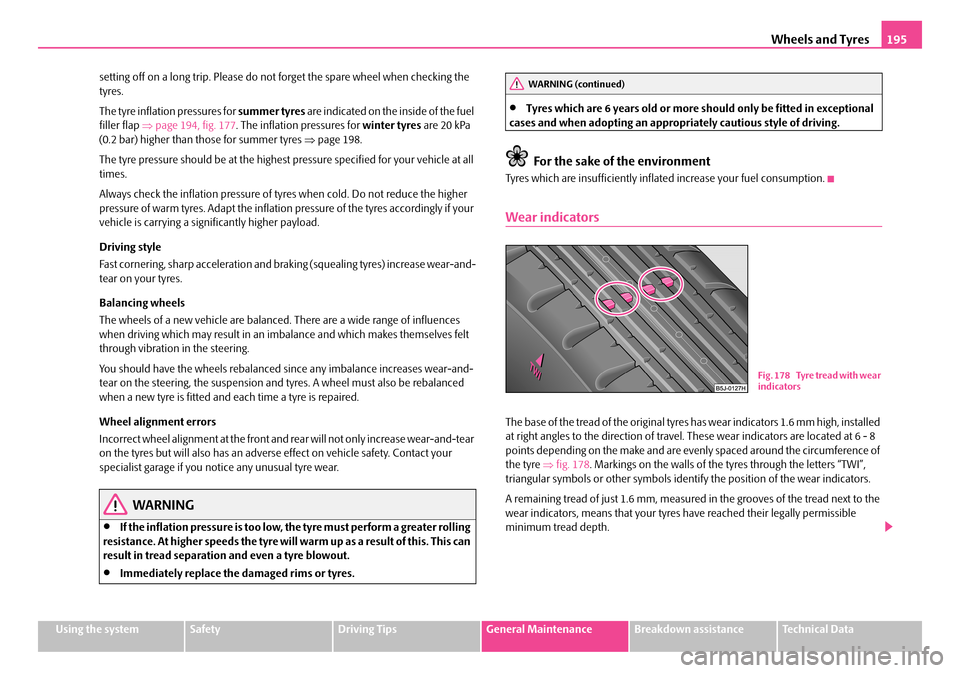
Wheels and Tyres195
Using the systemSafetyDriving TipsGeneral MaintenanceBreakdown assistanceTechnical Data
setting off on a long trip. Please do not forget the spare wheel when checking the tyres.
The tyre inflation pressures for summer tyres are indicated on the inside of the fuel filler flap ⇒page 194, fig. 177. The inflation pressures for winter tyres are 20 kPa (0.2 bar) higher than those for summer tyres ⇒page 198.
The tyre pressure should be at the highest pressure specified for your vehicle at all times.
Always check the inflation pressure of tyres when cold. Do not reduce the higher pressure of warm tyres. Adapt the inflation pressure of the tyres accordingly if your vehicle is carrying a significantly higher payload.
Driving style
Fast cornering, sharp acceleration and braking (squealing tyres) increase wear-and-tear on your tyres.
Balancing wheels
The wheels of a new vehicle are balanced. There are a wide range of influences when driving which may result in an imbalance and which makes themselves felt through vibration in the steering.
You should have the wheels rebalanced since any imbalance increases wear-and-tear on the steering, the suspension and tyres. A wheel must also be rebalanced when a new tyre is fitted and each time a tyre is repaired.
Wheel alignment errors
Incorrect wheel alignment at the front and rear will not only increase wear-and-tear on the tyres but will also has an adverse effect on vehicle safety. Contact your specialist garage if you notice any unusual tyre wear.
WARNING
•If the inflation pressure is too low, the tyre must perform a greater rolling resistance. At higher speeds the tyre will warm up as a result of this. This can result in tread separation and even a tyre blowout.
•Immediately replace the damaged rims or tyres.
•Tyres which are 6 years old or more should only be fitted in exceptional cases and when adopting an appropriately cautious style of driving.
For the sake of the environment
Tyres which are insufficiently inflated increase your fuel consumption.
Wear indicators
The base of the tread of the original tyres has wear indicators 1.6 mm high, installed at right angles to the direction of travel. These wear indicators are located at 6 - 8 points depending on the make and are evenly spaced around the circumference of the tyre ⇒fig. 178. Markings on the walls of the tyres through the letters “TWI”, triangular symbols or other symbols identify the position of the wear indicators.
A remaining tread of just 1.6 mm, measured in the grooves of the tread next to the wear indicators, means that your tyres have reached their legally permissible minimum tread depth.
WARNING (continued)
Fig. 178 Tyre tread with wear indicators
NKO A05F 20.book Page 195 Wednesday, April 2, 2008 1:02 PM
Page 199 of 252
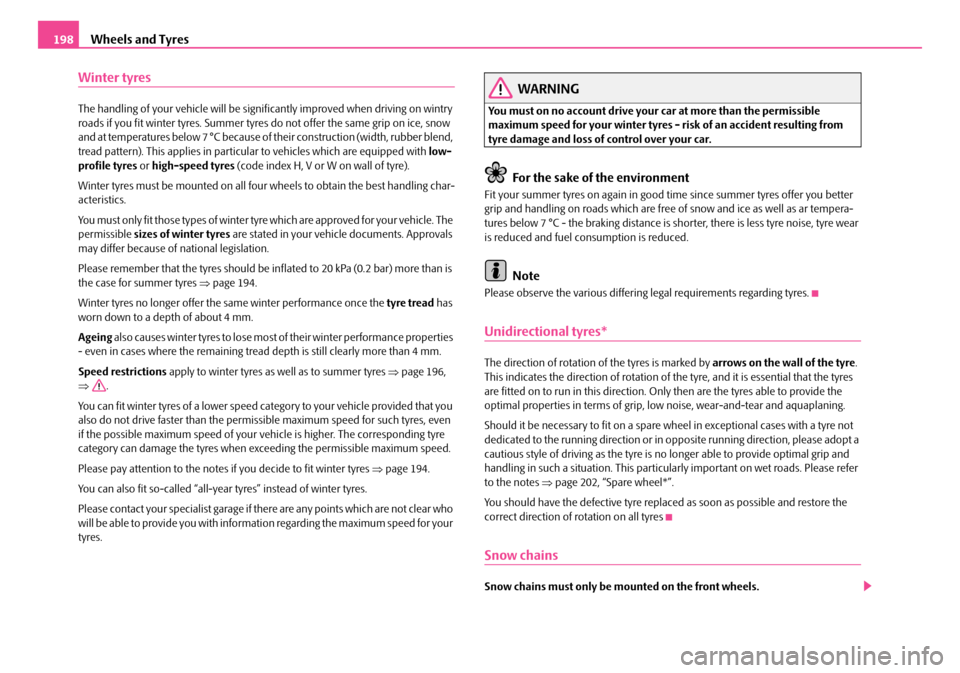
Wheels and Tyres198
Winter tyres
The handling of your vehicle will be significantly improved when driving on wintry roads if you fit winter tyres. Summer tyres do not offer the same grip on ice, snow and at temperatures below 7 °C because of their construction (width, rubber blend, tread pattern). This applies in particular to vehicles which are equipped with low-profile tyres or high-speed tyres (code index H, V or W on wall of tyre).
Winter tyres must be mounted on all four wheels to obtain the best handling char-acteristics.
You must only fit those types of winter tyre which are approved for your vehicle. The permissible sizes of winter tyres are stated in your vehicle documents. Approvals may differ because of national legislation.
Please remember that the tyres should be inflated to 20 kPa (0.2 bar) more than is the case for summer tyres ⇒page 194.
Winter tyres no longer offer the same winter performance once the tyre tread has worn down to a depth of about 4 mm.
Ageing also causes winter tyres to lose most of their winter performance properties - even in cases where the remaining tread depth is still clearly more than 4 mm.
Speed restrictions apply to winter tyres as well as to summer tyres ⇒page 196, ⇒.
You can fit winter tyres of a lower speed category to your vehicle provided that you also do not drive faster than the permissible maximum speed for such tyres, even if the possible maximum speed of your vehicle is higher. The corresponding tyre category can damage the tyres when exceeding the permissible maximum speed.
Please pay attention to the notes if you decide to fit winter tyres ⇒page 194.
You can also fit so-called “all-year tyres” instead of winter tyres.
Please contact your specialist garage if there are any points which are not clear who will be able to provide you with information regarding the maximum speed for your tyres.
WARNING
You must on no account drive your car at more than the permissible maximum speed for your winter tyres - risk of an accident resulting from tyre damage and loss of control over your car.
For the sake of the environment
Fit your summer tyres on again in good time since summer tyres offer you better grip and handling on roads which are free of snow and ice as well as ar tempera-tures below 7 °C - the braking distance is shorter, there is less tyre noise, tyre wear is reduced and fuel consumption is reduced.
Note
Please observe the various differing legal requirements regarding tyres.
Unidirectional tyres*
The direction of rotation of the tyres is marked by arrows on the wall of the tyre. This indicates the direction of rotation of the tyre, and it is essential that the tyres are fitted on to run in this direction. Only then are the tyres able to provide the optimal properties in terms of grip, low noise, wear-and-tear and aquaplaning.
Should it be necessary to fit on a spare wheel in exceptional cases with a tyre not dedicated to the running direction or in opposite running direction, please adopt a cautious style of driving as the tyre is no longer able to provide optimal grip and handling in such a situation. This particularly important on wet roads. Please refer to the notes ⇒page 202, “Spare wheel*”.
You should have the defective tyre replaced as soon as possible and restore the correct direction of rotation on all tyres
Snow chains
Snow chains must only be mounted on the front wheels.
NKO A05F 20.book Page 198 Wednesday, April 2, 2008 1:02 PM
Page 225 of 252
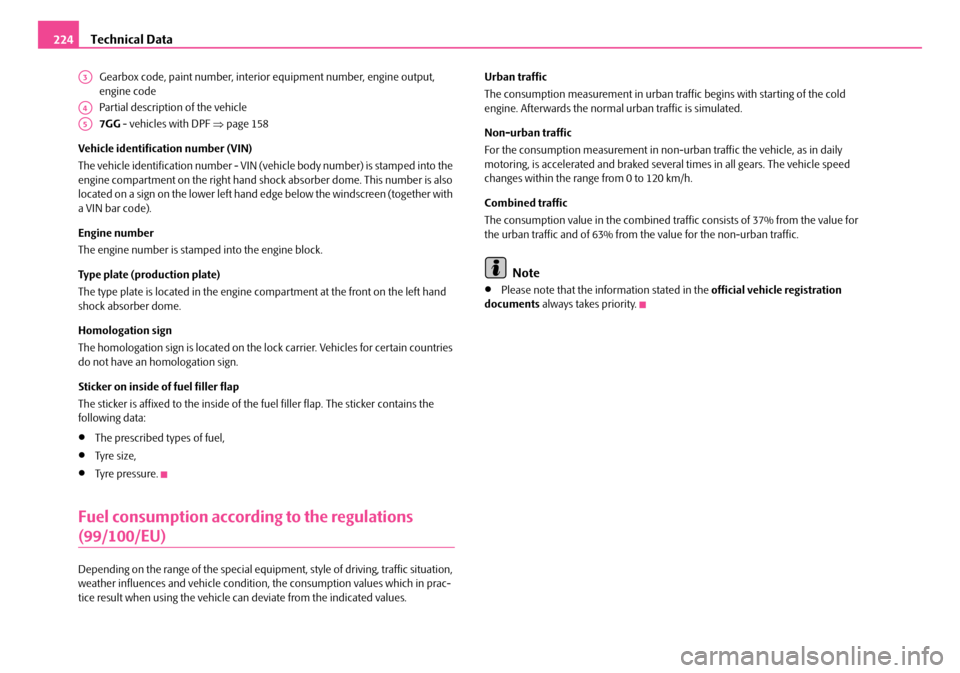
Technical Data224
Gearbox code, paint number, interior equipment number, engine output, engine code
Partial description of the vehicle
7GG - vehicles with DPF ⇒page 158
Vehicle identification number (VIN)
The vehicle identification number - VIN (vehicle body number) is stamped into the engine compartment on the right hand shock absorber dome. This number is also located on a sign on the lower left hand edge below the windscreen (together with a VIN bar code).
Engine number
The engine number is stamped into the engine block.
Type plate (production plate)
The type plate is located in the engine compartment at the front on the left hand shock absorber dome.
Homologation sign
The homologation sign is located on the lock carrier. Vehicles for certain countries do not have an homologation sign.
Sticker on inside of fuel filler flap
The sticker is affixed to the inside of the fuel filler flap. The sticker contains the following data:
•The prescribed types of fuel,
•Tyre si z e,
•Tyre pressure.
Fuel consumption according to the regulations
(99/100/EU)
Depending on the range of the special equipment, style of driving, traffic situation, weather influences and vehicle condition, the consumption values which in prac-tice result when using the vehicle can deviate from the indicated values.
Urban traffic
The consumption measurement in urban traffic begins with starting of the cold engine. Afterwards the normal urban traffic is simulated.
Non-urban traffic
For the consumption measurement in non-urban traffic the vehicle, as in daily motoring, is accelerated and braked several times in all gears. The vehicle speed changes within the range from 0 to 120 km/h.
Combined traffic
The consumption value in the combined traffic consists of 37% from the value for the urban traffic and of 63% from the value for the non-urban traffic.
Note
•Please note that the information stated in the official vehicle registration documents always takes priority.
A3
A4
A5
NKO A05F 20.book Page 224 Wednesday, April 2, 2008 1:02 PM
Page 227 of 252

Technical Data226
1.2 l/44 kW - EU 4/EU 2DDK
Engine
Performances
Fuel consumption (in ltr./100 km) and CO2 emission (in g/km)
Power outputkW per rpm44/5200
Maximum torqueNm per rpm108/3000
Number of cylinders/Displacement (cm3)3/1198
Fuel - unleaded petrol min. RON95
FA B I ACO M B I
Maximum speedkm/h155156
Acceleration 0 - 100 km/hs16,516,8
Urban7,8
Non-urban4,8
Combination5,9
CO2 emission - combination140
NKO A05F 20.book Page 226 Wednesday, April 2, 2008 1:02 PM
Page 229 of 252

Technical Data228
1.2 l/51 kW - EU 4/EU 2DDK
Engine
Performances
Fuel consumption (in ltr./100 km) and CO2 emission (in g/km)
Power outputkW per rpm51/5400
Maximum torqueNm per rpm112/3000
Number of cylinders/Displacement (cm3)3/1198
Fuel - unleaded petrol min. RON95
FA B I ACOMBI
Maximum speedkm/h163164
Acceleration 0 - 100 km/hs14,915,1
Urban7,7
Non-urban4,9
Combination5,9
CO2 emission - combination140
NKO A05F 20.book Page 228 Wednesday, April 2, 2008 1:02 PM
Page 231 of 252

Technical Data230
1,4 l/63 kW - EU 4/EU 2DDK
Engine
Performances
Fuel consumption (in ltr./100 km) and CO2 emission (in g/km)
Power outputkW per rpm63/5000
Maximum torqueNm per rpm132/3800
Number of cylinders/Displacement (cm3)4/1390
Fuel - unleaded petrol min. RON95
FA B I ACO M B I
Maximum speedkm/h174175
Acceleration 0 - 100 km/hs12,312,7
Urban8,6
Non-urban5,3
Combination6,5
CO2 emission - combination155
NKO A05F 20.book Page 230 Wednesday, April 2, 2008 1:02 PM
Page 233 of 252
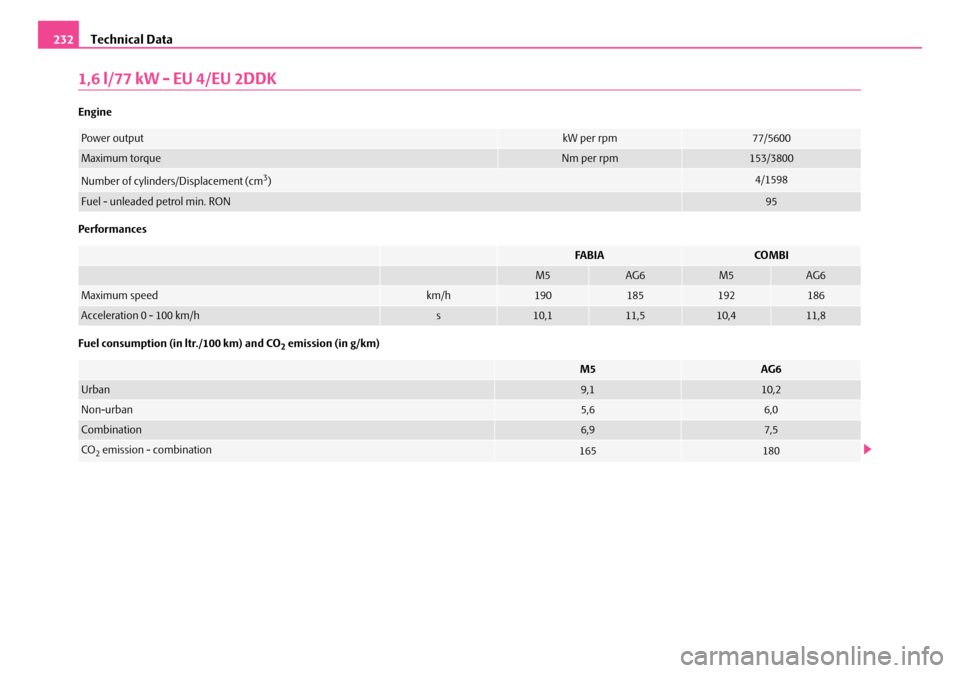
Technical Data232
1,6 l/77 kW - EU 4/EU 2DDK
Engine
Performances
Fuel consumption (in ltr./100 km) and CO2 emission (in g/km)
Power outputkW per rpm77/5600
Maximum torqueNm per rpm153/3800
Number of cylinders/Displacement (cm3)4/1598
Fuel - unleaded petrol min. RON95
FA B I ACOMBI
M5AG6M5AG6
Maximum speedkm/h190185192186
Acceleration 0 - 100 km/hs10,111,510,411,8
M5AG6
Urban9,110,2
Non-urban5,66,0
Combination6,97,5
CO2 emission - combination165180
NKO A05F 20.book Page 232 Wednesday, April 2, 2008 1:02 PM
Page 235 of 252
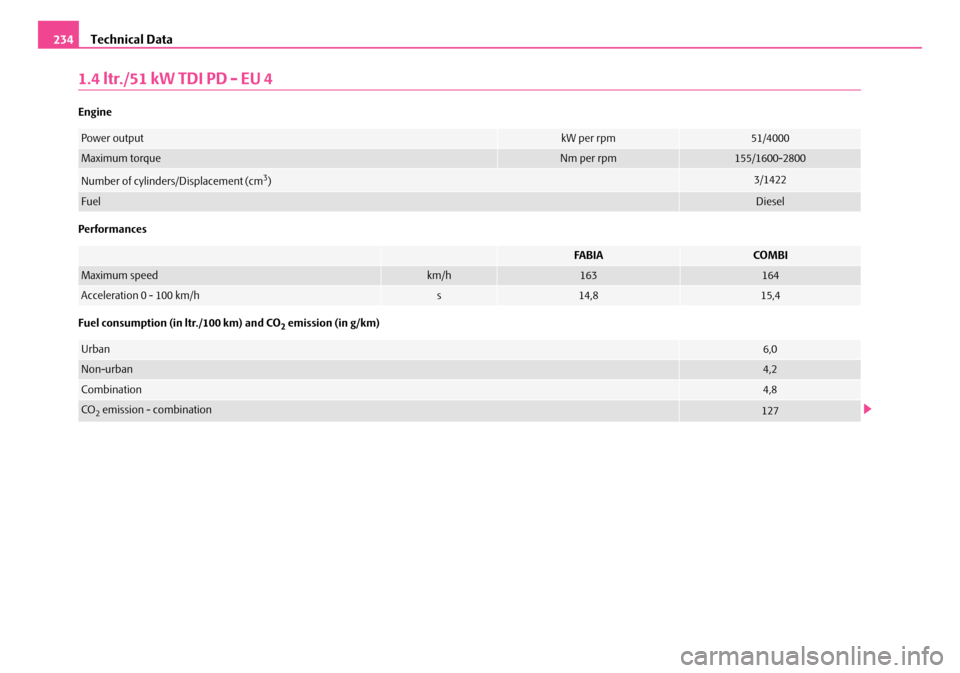
Technical Data234
1.4 ltr./51 kW TDI PD - EU 4
Engine
Performances
Fuel consumption (in ltr./100 km) and CO2 emission (in g/km)
Power outputkW per rpm51/4000
Maximum torqueNm per rpm155/1600-2800
Number of cylinders/Displacement (cm3)3/1422
FuelDiesel
FA B I ACO M B I
Maximum speedkm/h163164
Acceleration 0 - 100 km/hs14,815,4
Urban6,0
Non-urban4,2
Combination4,8
CO2 emission - combination127
NKO A05F 20.book Page 234 Wednesday, April 2, 2008 1:02 PM
Page 237 of 252
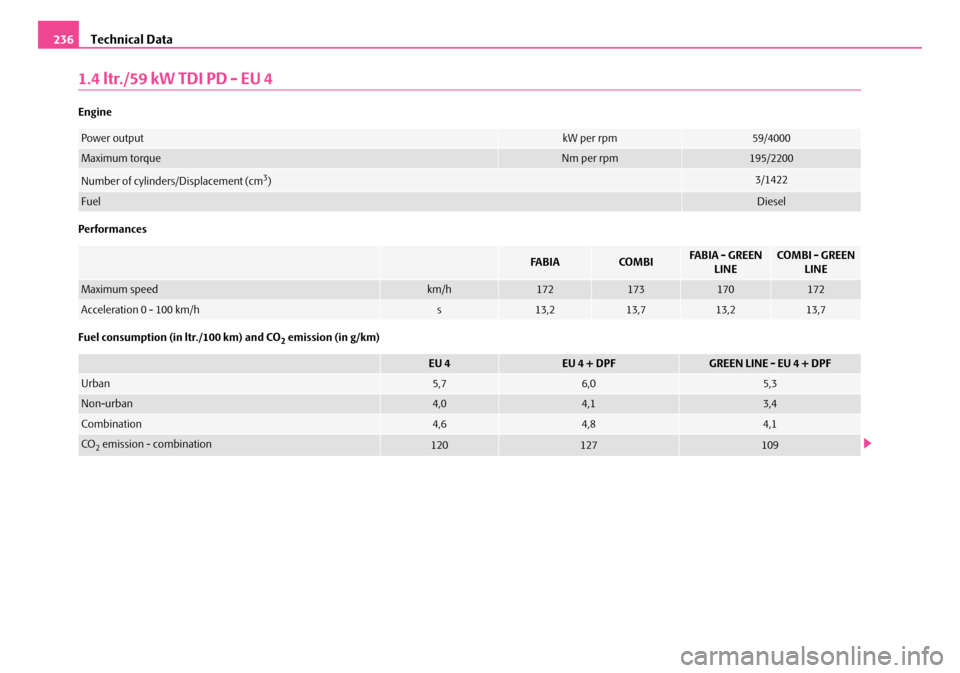
Technical Data236
1.4 ltr./59 kW TDI PD - EU 4
Engine
Performances
Fuel consumption (in ltr./100 km) and CO2 emission (in g/km)
Power outputkW per rpm59/4000
Maximum torqueNm per rpm195/2200
Number of cylinders/Displacement (cm3)3/1422
FuelDiesel
FA B I ACOMBIFA B I A - G R E E N LINECOM B I - G RE EN LINE
Maximum speedkm/h172173170172
Acceleration 0 - 100 km/hs13,213,713,213,7
EU 4EU 4 + DPFGREEN LINE - EU 4 + DPF
Urban5,76,05,3
Non-urban4,04,13,4
Combination4,64,84,1
CO2 emission - combination120127109
NKO A05F 20.book Page 236 Wednesday, April 2, 2008 1:02 PM
Page 239 of 252
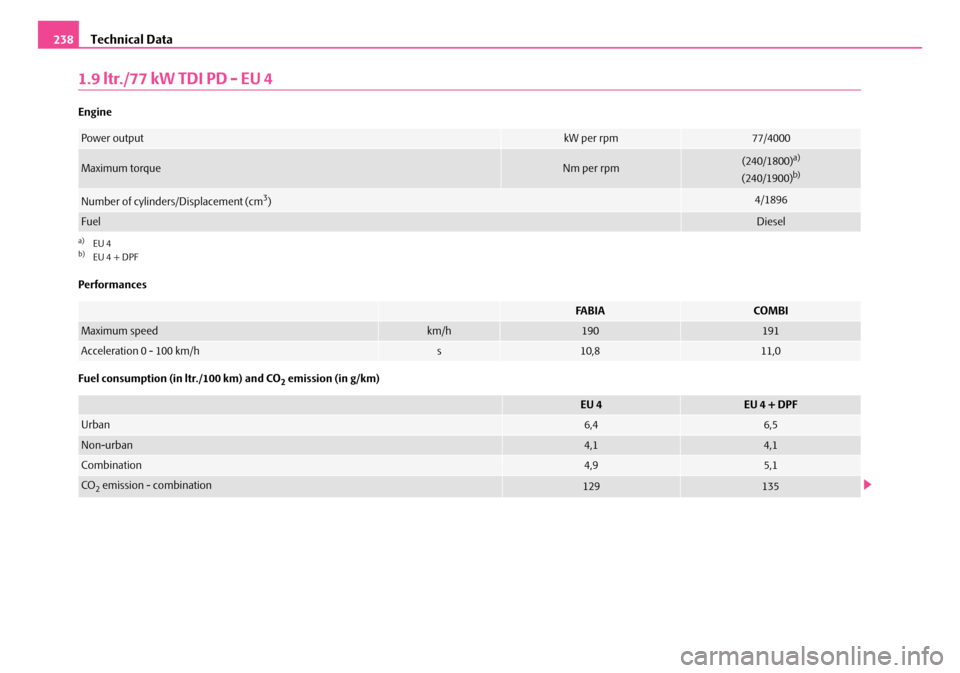
Technical Data238
1.9 ltr./77 kW TDI PD - EU 4
Engine
Performances
Fuel consumption (in ltr./100 km) and CO2 emission (in g/km)
Power outputkW per rpm77/4000
Maximum torqueNm per rpm(240/1800)a)
(240/1900)b)
a)EU 4b)EU 4 + DPF
Number of cylinders/Displacement (cm3)4/1896
FuelDiesel
FA B I ACOMBI
Maximum speedkm/h190191
Acceleration 0 - 100 km/hs10,811,0
EU 4EU 4 + DPF
Urban6,46,5
Non-urban4,14,1
Combination4,95,1
CO2 emission - combination129135
NKO A05F 20.book Page 238 Wednesday, April 2, 2008 1:02 PM